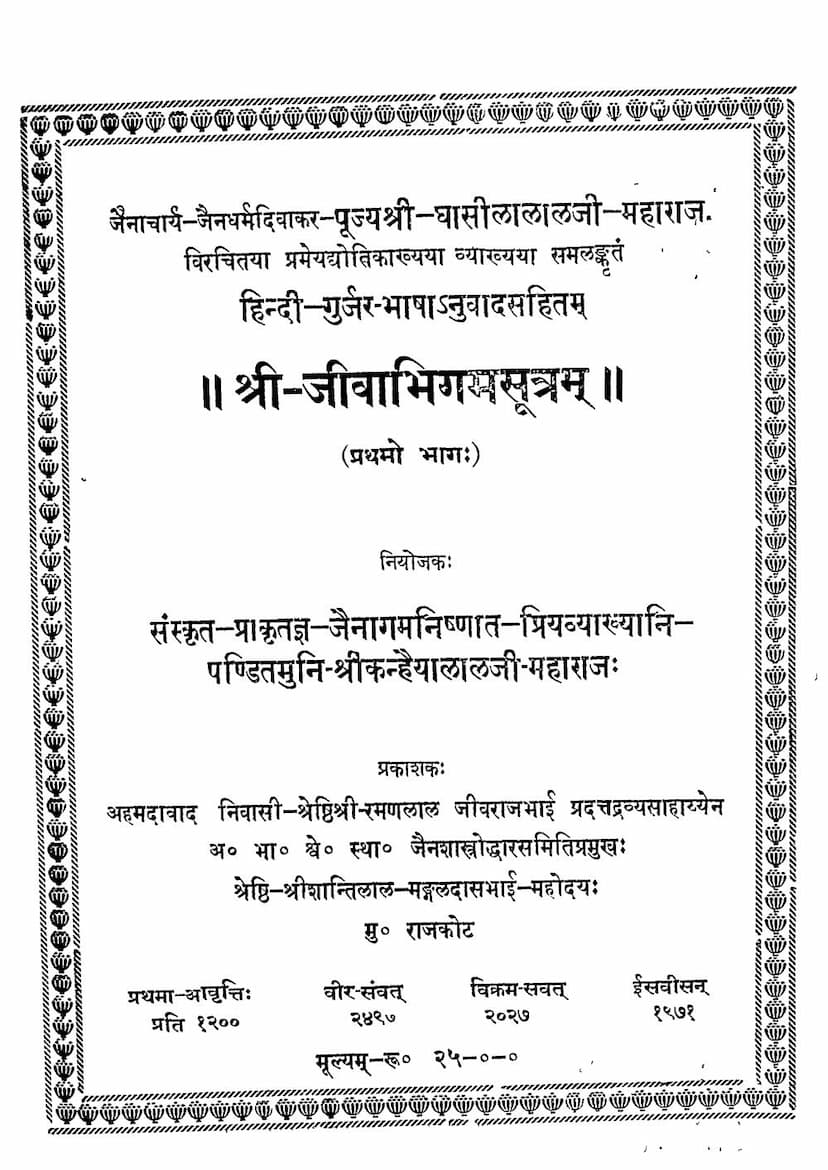Jivajivabhigamsutra Part 01
Added to library: September 2, 2025

Summary
Here's a comprehensive summary of the provided Jain text, "Jivajivabhigamsutra Part 01," based on the provided pages, highlighting its key aspects:
Book Title: Sri Jivabhigamasutra, Part 1 Author: Jainacharya Jain-Dharm Diwakar Pujya Ghasilalji Maharaj Commentary: Prameyadyotikakhya Vyakhya by Muni Ghasi Lalji Translator/Editor: Pandit Muni Shri Kanhaiyalalji Maharaj Publisher: Akhil Bharat Shwetambar Sthanakwasi Jain Shastroddhar Samiti Catalog Link: https://jainqq.org/explore/009335/1
Overall Purpose: The Jivajivabhigamasutra, as presented in this volume, is a foundational Jain text that delves into the nature of living beings (Jiva) and non-living beings (Ajiva). The commentary "Prameyadyotika" aims to elucidate these complex concepts for the benefit of those with limited intellect, making the profound teachings of Jainism accessible.
Key Themes and Content (Based on the Table of Contents and introductory pages):
The text is structured into two major sections ("Pratipatti"):
Part 1: Dwividha Pratipatti (Twofold Consideration)
This section primarily focuses on the classification and characteristics of living and non-living entities, introducing fundamental Jain principles. The detailed table of contents (pages 3 & 4) reveals a systematic exploration of various aspects of existence within the Jain cosmology:
- Mangalacharan (Invocation): The text begins with auspicious verses (Mangalacharan) to the Tirthankara Mahavir and his chief disciple Gautam, seeking blessings for the endeavor of explaining the scripture.
- Introduction to Jivajivabhigama: The text introduces the subject matter, emphasizing the need to understand the nature of Jivas (souls) and Ajivas (non-souls) for liberation from suffering.
- Classification of Ajiva and Jiva: The initial chapters outline the nature of Ajivas and then Jivas, establishing the core ontological categories.
- Detailed Dwelling on the 23 Doors (Dwar): A significant portion of the first section is dedicated to the exposition of 23 essential attributes or categories ("Dwar") that describe living beings. These include:
- Body (Sharira)
- Extent/Space (Avagahana)
- Structure/Union (Sanhanan)
- Form/Configuration (Sansthan)
- Passions (Kashay)
- Consciousness/Perception (Sanjna)
- Gleam/Aura (Leshya)
- Sense Organs (Indriya)
- Resounding/Emanation (Samuddhata)
- Consciousness (Sanjna) - Repeated, likely with a different nuance or context.
- Sexuality (Veda)
- Perfection/Completion (Paryapti)
- Aspects related to perception, knowledge, karma, etc., further elaborated through various 'doors' like Drishti (view), Darshan (perception), Gyan (knowledge), Yoga, Upayoga (consciousness application), etc.
- Detailed Classification of Life Forms: The text then moves on to provide a detailed account of various life forms, particularly focusing on their characteristics as per the 23 doors. This includes:
- Infernal beings (Naraka)
- Mobile beings (Trasa) - further broken down into various classifications based on the number of senses (two-sensed, three-sensed, four-sensed, five-sensed).
- Immobile beings (Sthavara) - including earth-bodied (Prithvikaya), water-bodied (Jal Kaya), fire-bodied (Tej Kaya), air-bodied (Vayu Kaya), and vegetation-bodied (Vanaspati Kaya) souls.
- Specific details are provided for different types of vegetation souls (Ek-pratyek, Sadharan) and mobile souls, including detailed descriptions of their states and attributes.
- Emphasis on "Alpa-Bahutva": A recurring theme is the comparison of the number of souls in different categories (Alpa-Bahutva), highlighting the vastness of souls in some forms of existence compared to others.
- Introduction of "Trividha Pratipatti" (Third Consideration): The table of contents (Page 5) indicates the transition to the second major part of the text, which deals with threefold considerations. This suggests a deeper dive into various classifications, possibly related to gender, types of beings, or stages of existence.
Biographical Information:
The introductory pages (Pages 6-15) provide biographical details about Seth Shri Jivrajbhai Mulchand Shah, the benefactor whose financial support made the publication possible. He is described as a devout Jain follower who dedicated his life to spiritual practices, knowledge, meditation, and service to Jain monks and nuns. His life was marked by strong religious convictions, generosity, and adherence to Jain principles, even while engaging in business. The text also includes a family tree, highlighting his lineage and the continuation of his philanthropic and spiritual legacy through his son and grandchildren.
Commentary and Translation:
The presence of a Hindi and Gujarati translation alongside the Sanskrit-Prakrit original text, and the detailed commentary "Prameyadyotika," signifies a commitment to making the Jivajivabhigamasutra accessible to a wider audience interested in Jain philosophy.
In essence, this first part of the Jivajivabhigamasutra, illuminated by the Prameyadyotika commentary, serves as a comprehensive guide to understanding the fundamental Jain principles of existence, focusing on the intricate classifications and characteristics of Jivas and Ajivas, and providing a detailed exploration of the attributes that define various life forms.